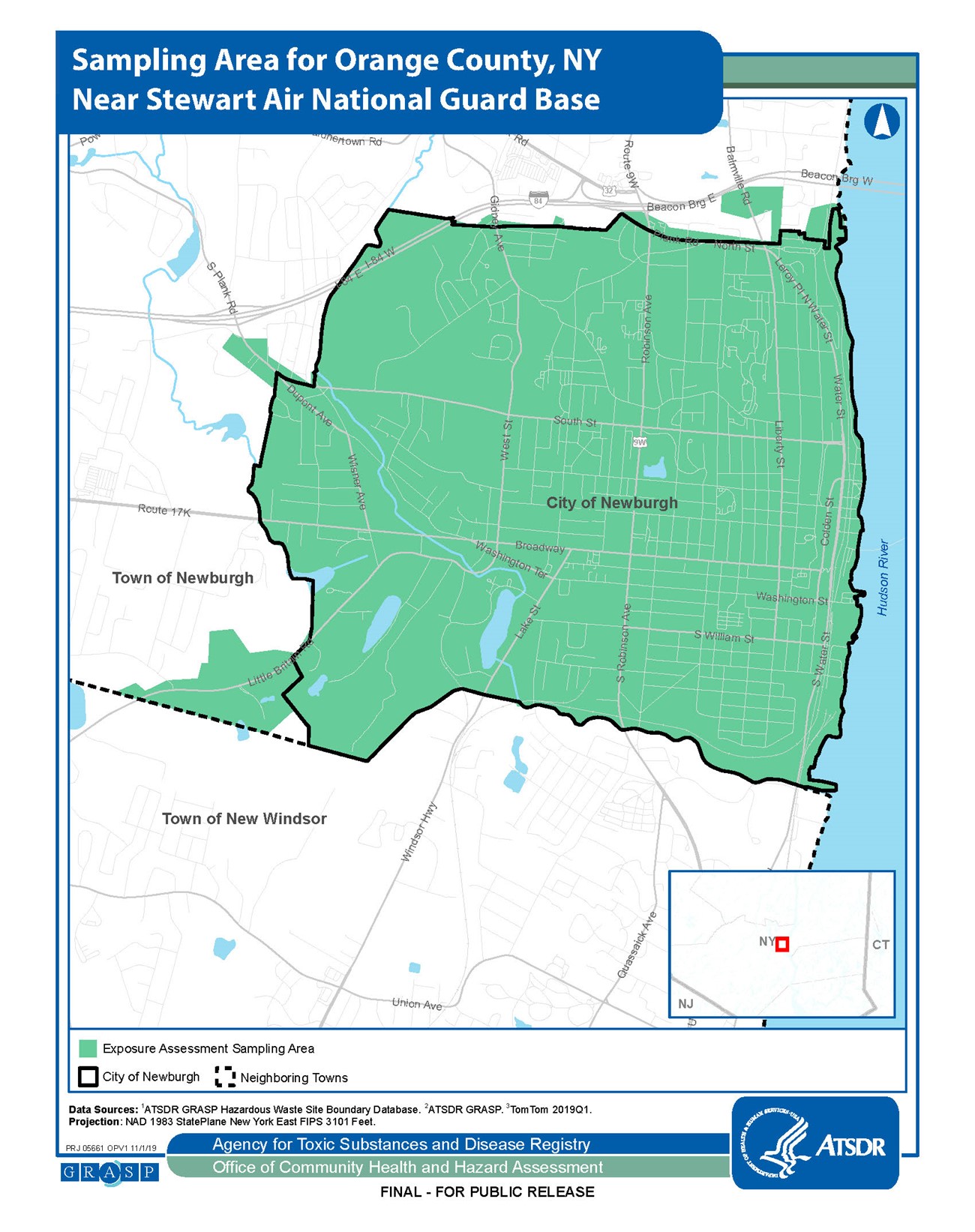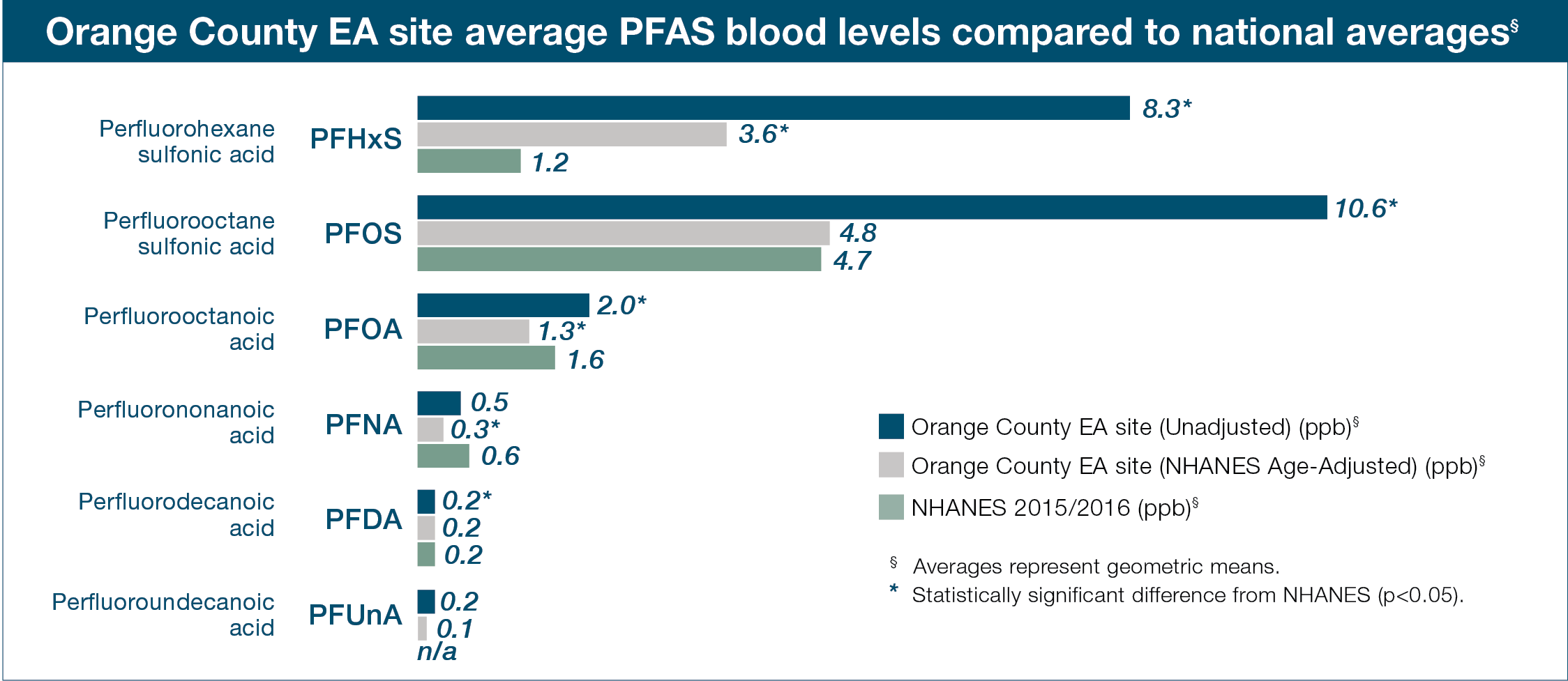Key points
- Elevated blood levels of PFHxS in participants may be linked with past drinking water contamination.
- PFAS in drinking water was from use of products like aqueous film forming foam (AFFF).
- Six PFAS were detected in more than 84% of the blood samples collected.

Background
Water test results
ATSDR does not recommend an alternate source of drinking water at this time. The is based on the PFAS drinking water test results from the City of Newburgh's public drinking water system.
In 2020, the Centers for Disease Control and Prevention (CDC) and the Agency for Toxic Substances and Disease Registry (ATSDR) conducted an exposure assessment (EA) in Orange County, New York, near Stewart Air National Guard Base (the Base).
CDC and ATSDR sent the individual test results to participants and released summary results to the community in May 2021. The per- and polyfluoroalkyl substances (PFAS) exposure assessment report was released in June 2022
Why the Orange County EA site was selected
When selecting EA sites, ATSDR considered the extent of PFOA and PFOS contamination in drinking water supplies. It also considered the:
- Duration of time that exposure may have occurred.
- Number of potentially affected residents.
The Orange County site was one of several nationwide identified with PFAS drinking water contamination from use of products such as AFFF.
The Base previously used AFFF containing PFAS for its firefighter training. It is not known when AFFF was first used, but it is believed to have started as early as the 1980s. Over time, the PFAS from the AFFF entered the ground and got into the groundwater to offsite locations. This affected Washington Lake, the City of Newburgh's surface water source.
To reduce levels of PFAS in drinking water, City of Newburgh authorities stopped using Washington Lake as its water source in May 2016 Since then, New York City's Catskill Aqueduct has served as the primary water supply.
Based on information reviewed by ATSDR, the City of Newburgh drinking water supply currently meets or is below the U.S. Environmental Protection Agency's (EPA) 2016 health advisory (HA) and state public health standards for PFAS in drinking water.
Sampling area

Timeline
Information session
Meeting date: 02/11/20
Recruitment begins
Letters sent following the information session
Letters sent 02/11/20
Recruitment paused March 2020
Phone calls start 09/30/20Field work/sample collection
Biological/questionnaire 10/2020
Environmental 05/2021Samples analyzed
Completed
Individual test results
Biological 05/2021
Environmental 09/2021EA site report
Findings and recommendations released 06/29/2022
Community meeting
Met 07/12/2022
How testing was conducted
ATSDR invited randomly selected households to participate in the EA. To be eligible to participate, household residents must have:
- Lived within the sampling frame.
- Received their drinking water from the City of Newburgh's public drinking water system for at least one year before May 2, 2016.
- Been older than three years at the time of sample collection.
- Not been anemic or had a bleeding disorder that would prevent giving a blood sample.
Households with private wells were not eligible to participate. Measuring PFAS in the blood of people from randomly selected households allows us to estimate exposure from consumption of public drinking water for the entire community in the affected area, even those who were not tested.
Results
In May and September 2021, CDC and ATSDR released a summary of the biological and environmental test results, respectively. The full report was released on June 28, 2022. A summary of its findings is below.
In October 2020, ATSDR collected samples and other information from participants. ATSDR analyzed data from:
- 59 people, including
- 58 adults.
- 1 child.
- 58 adults.
- 48 households.
- Questionnaires completed by all participants.
- Blood and urine samples provided by most participants.
- Samples of tap water and dust from some homes.
ATSDR sent individual biological and environmental results to each participant in May and September 2021, respectively.
Key takeaways
Average age-adjusted levels of PFHxS in the blood of Orange County EA site participants were three times national levels. Other PFAS were not higher than the national average or were detected too infrequently to compare to national averages.
- Elevated blood levels may be linked with past drinking water contamination.
- Some demographic and lifestyle characteristics were linked with higher PFAS blood levels.
- All tap water samples collected during the EA in 2021 met the EPA's 2016 HA and New York State public health standards for PFAS in drinking water.
Additional testing at the site
No PFAS were detected in urine.
All tap water samples collected during the EA in 2021 met the EPA's 2016 HA and New York State public health standards for PFAS in drinking water.
PFAS contamination in house dust was similar to that reported in other studies (with and without PFAS contamination). This likely contributed to PFAS levels in the blood.
PFAS concentrations in participants' blood are declining over time in Orange County EA.
A total of 23 participants shared previous (2016 or 2017) PFAS blood results.
A comparison with EA results showed PFAS blood levels decreased in all participants:
- PFHxS decreased – 17%-80%
- PFOS decreased – 34%-86%
- PFOA decreased – 17%-80
Future direction
What was learned about PFAS levels in blood
Did you know?
Of the seven PFAS tested at the Orange County EA site, six PFAS were detected in more than 84% of the blood samples collected:
- PFHxS
- PFOS
- PFOA
- PFNA
- PFDA
- PFUnA
Since 1999, the National Health and Nutrition Examination Survey (NHANES) has measured PFAS levels in blood in the U.S. population. PFAS levels are shown to be age dependent and tend to increase with age in part due to longer periods of exposure.
ATSDR adjusted blood levels of study participants in the Orange County EA site community for age to enable meaningful comparison to the NHANES dataset. After adjustment, PFHxS levels remained higher than national levels. Age-adjusted averages are more representative of the Orange County EA site community.

Information to protect our communities
Did you know?
PFHxS, PFOS, and PFOA were detected in the City of Newburgh water supply as early as 2013. Since no data are available prior to 2013, we do not know if contamination began earlier.
In 2016, the City of Newburgh reduced concentrations of PFAS below U.S. EPA HA levels by switching its water source. There were four years and five months between the reduction of exposure via contaminated drinking water and the collection of the EA blood samples.
Due to the long half-lives of PFHxS, PFOS, and PFOA in humans, past drinking water exposures may have contributed to the participants' blood levels. PFHxS has the longest estimated half-life of the three compounds, which may contribute to why it exceeded the national average by the largest margin.
It was found that long-time residents had higher PFHxS levels. Taken together, the data suggest that past drinking water exposure contributed to the elevated blood levels of PFHxS observed in the Orange County EA participants.
What this means for residents
This EA shows that past exposures to PFAS in drinking water have impacted the levels of some PFAS in people. These PFAS are eliminated from the body over a long period of time. This allowed ATSDR to measure PFAS even though exposures through drinking water were lowered years ago.
Although exposure from PFAS in the city's drinking water in Orange County has been reduced, there are actions community members and city officials can take to further reduce exposures to PFAS and protect public health.
Statistical findings
ATSDR used statistical models to study relationships between various demographic and lifestyle characteristics of the tested residents and PFAS blood levels. The models showed that, in general:
PFHxS, PFOS*, and PFOA levels in blood changed with age.
Blood levels for these compounds in females increased by 2.4% to 5.4% for every year of participant age.
Blood levels for these compounds in males decreased by 0.58% to 1.3% for every year of participant age.
Males had higher blood levels of PFHxS, PFOS, and PFOA than females. The difference between males and females was larger in younger people.
Residents reporting eating locally grown fruits or vegetables had 44% higher PFUnA blood levels than those who did not.
What the community can do
For information on water quality, become familiar with Consumer Confidence Reports.
Private well owners living in the area affected by PFAS should consider having their wells tested for PFAS if testing has not been conducted before.
Verify a water filter's ability to reduce PFOA and PFOS. NSF International, the global health organization, developed a test method to verify a water filter's ability to reduce PFOA and PFOS to below the health advisory levels set by the EPA.
To find NSF International-approved devices, go to the bottom of the NSF Certified Drinking Water Treatment Units page. Then check the boxes for PFOA Reduction and PFOS Reduction.
Nursing mothers should continue breastfeeding. Based on current science, the known benefits of breastfeeding outweigh the risks for infants exposed to PFAS in breast milk.
Eliminate or decrease potential exposure to PFAS when possible. This pertains to consumer products such as stain-resistant products and food packaging materials.
Pay attention to advisories about food consumption, such as local fish advisories.
Discuss any health concerns or symptoms with your health care provider. Share results of PFAS blood testing with your health care provider and make them aware of ATSDR resources for clinicians.
Follow the advice of your health care provider and the recommendations for checkups, vaccinations, prenatal care, and health screening tests.
Join the multi-site health study, funded by ATSDR. This includes the Orange County area (Hoosick Falls and Newburgh). The study was conducted by the New York State Department of Health and the University of Albany's School of Public Health. If you participated, or want further information, please visit Multi-Site PFAS Health Study | University at Albany.
Additional blood testing for PFAS. At this time, ATSDR does not have plans to conduct additional blood testing. It also does not recommend PFAS EA participants get individually retested for PFAS in blood. The biological half-lives of many of the PFAS measured in people's blood are long. PFHxS has one of the longest half-lives. This means that PFAS blood levels are not expected to change significantly in the near-term, even if exposure stops. It is also unclear what an individual's PFAS test results mean in terms of possible health effects.
For the general population, blood tests for PFAS are most useful when they are part of a scientific investigation like this EA. Test results will tell you how much of each PFAS is in your blood, but it is unclear what the results mean in terms of possible health effects. In addition, blood testing for PFAS is not a routine test offered by most doctors or health departments. If you are concerned about the effect of PFAS on your health, talk to your health care provider and make them aware of ATSDR resources for clinicians.
For your child, follow the advice of their health care provider and the recommendations for well child checkups, vaccinations, and health screening tests. Consult My Health Finder to help identify those vaccinations and tests.
For more information about environmental exposures and children's health, contact the Pediatric Environmental Health Specialty Units, a nationwide network of experts in reproductive and children's environmental health.
What the City of Newburgh can do
Operators of public water systems should continue to monitor concentrations of PFAS in drinking water delivered to the Newburgh community. This will ensure that concentrations of PFAS remain below the EPA's HA or other applicable guidelines for specific PFAS in drinking water.
Results of PFAS monitoring should be shared with community members through appropriate communication channels.
All treatment systems to remove PFAS from the municipal drinking water in the City of Newburgh should be properly maintained.

